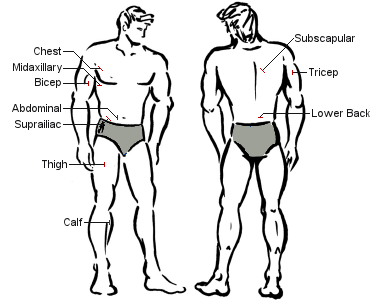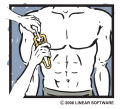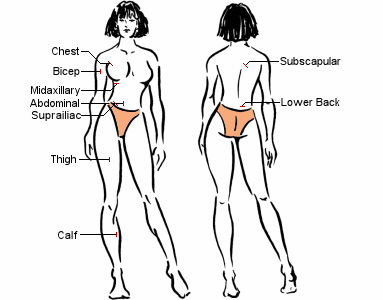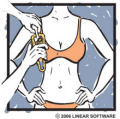Miss Candace
This week's subject: % of BODY FAT
Jan 14, 2010
I truly had no idea what body fat is, why it's important, what % I should be at, or why I should aim for that %! Here's an article I found on:Understanding Your Body Fat Percentage http://www.healthchecksystems.com/bodyfat.htm
Body fat measurements and the measuring tape are recognized as superior methods for measuring "weight loss". When one declares that they want to "lose weight", what they often mean is that they want to lose fat. So, now that you've had your body fat percentage measured, what does the number really mean? 
First, your body fat percentage is simply the percentage of fat your body contains. If you are 150 pounds and 10% fat, it means that your body consists of 15 pounds fat and 135 pounds lean body mass (bone, muscle, organ tissue, blood and everything else).
A certain amount of fat is essential to bodily functions. Fat regulates body temperature, cushions and insulates organs and tissues and is the main form of the body's energy storage. The following table describes body fat ranges and their associated categories:
*General Body Fat Percentage Categories
| Classification | Women (% fat) | Men (% fat) |
|---|---|---|
| Essential Fat | 10-12% | 2-4% |
| Athletes | 14-20% | 6-13% |
| Fitness | 21-24% | 14-17% |
| Acceptable | 25-31% | 18-25% |
| Obese | 32% plus | 25% plus |
Knowing your body fat percentage can also help you determine if your weight loss goals are realistic. Remember, weight loss doesn't always mean fat loss. For example:
Let's say you're a 130# woman with 23% body fat, and you goal is to "lose 20 pounds":
Initial body fat: 130# x 0.23 fat = 30 # body fat
Lean body mass: 130# total - 30# fat = 100# lean body mass (bones, organs and all else)
Goal: 130# - 20# = 110 pounds
As you can see, the goal of losing 20 pounds is not realistic or healthy. At 110 pounds, this woman still requires 100# of lean body mass (bones, organs, etc.), but would only be carrying 10#, or only 9% body fat. From the chart above, you can see that this is a dangerously low percentage.
A better goal might be for the woman to reduce her body fat from 23% to 18%. In this case:
130# x 0.18 = 23 # body fat
100# lean body mass + 23 # = 123# goal weight
So, for this individual to achieve a lean, but healthy 18% fat, she would need to lose only 7 pounds of fat, reducing her weight from her current 130 pounds to 123 pounds. Losing more than 7 pounds means losing lean body mass (usually metabolically-active muscle tissue), which is clearly not desirable.
So before you decide that you need to "lose weight", remember to consider that "weight" consists of both lean body mass and body fat. Try to keep your weight loss goals realistic, and remember, keep the calorie-burning muscle, and lose only the fat.
To help reinforce this practice/habit, I found the following data & body fat calculator at
Online Body Fat Calculator for Men and Women.
However, to ensure you receive accurate data, you will have to visit the site at http://www.linear-software.com/online.html to use the calculator tool as not all of the fields are importing on this end properly.
 Body Fat Caliper Measurement Sites - Men
Body Fat Caliper Measurement Sites - Men
Chest - Diagonal fold, midway between upper armpit and nipple
Midaxillary - Horizontal fold, directly below armpit
Bicep - Vertical fold, halfway between shoulder and elbow, directly on bicep
Abdominal - Vertical fold, one inch to the right of navel
Suprailiac - Diagonal fold, directly above iliac crest
Thigh- Vertical fold, midway between knee cap and top of thigh
Calf - Vertical fold, inside of leg on largest part of calf
Subscapular - Diagonal fold, directly below shoulder blade
Tricep - Vertical fold, midway between elbow and shoulder
Lower Back - Horizontal fold, directly over the kidneys, and 2 inches to the right of spine
 Click here for images for body fat calculator measurement sites
Click here for images for body fat calculator measurement sites
![]()
Body Fat Caliper Procedures1
1.) All measurement should be made on the right side of the body
2.) Caliper should be placed 1 cm away from thumb and finger, perpendicular to skinfold, and halfway between crest and base of fold
3.) Pinch should be maintained while reading the caliper
4.) Wait 1 to 2 s (and not longer) before reading caliper
5.) Take duplicate measures at each site and retest if duplicate measurements are not within 1 to 2 mm
6.) Rotate through measurement sites or allow time for skin to regain normal texture and thickness
![]()
1American College of Sports Medicine. ACSM's Guidelines For Exercise Testing and Prescription. 6th Edition. USA, Lippincott Williams & Wilkins 2000;65.

Chest - Diagonal fold, one third of the way between upper armpit and nipple
Midaxillary - Horizontal fold, directly below armpit
Bicep - Vertical fold, halfway between shoulder and elbow, directly on bicep
Abdominal - Vertical fold, one inch to the right of navel
Suprailiac - Diagonal fold, directly above iliac crest
Thigh- Vertical fold, midway between knee cap and top of thigh
Calf - Vertical fold, inside of leg on largest part of calf
Subscapular - Diagonal fold, directly below shoulder blade
Tricep - Vertical fold, midway between elbow and shoulder
Lower Back - Horizontal fold, directly over the kidneys, and 2 inches to the right of spine
 Click here for images for body fat calculator measurement sites
Click here for images for body fat calculator measurement sitesBody Fat Caliper Procedures1
1.) All measurement should be made on the right side of the body
2.) Caliper should be placed 1 cm away from the thumb and finger, perpendicular to the skinfold, and halfway between the crest and the base of the fold
3.) Pinch should be maintained while reading the caliper
4.) Wait 1 to 2 s (and not longer) before reading caliper
5.) Take duplicate measures at each site and retest if duplicate measurements are not within 1 to 2 mm
6.) Rotate through measurement sites or allow time for skin to regain normal texture and thickness
1American College of Sports Medicine. ACSM's Guidelines For Exercise Testing and Prescription. 6th Edition. USA, Lippincott Williams & Wilkins 2000;65.
Here's to conquering body fat!
